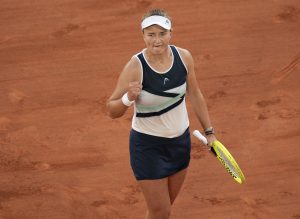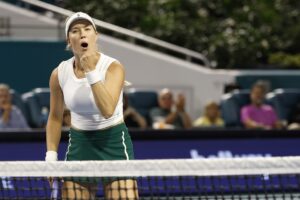We recently took a look at the best male players who never won Wimbledon. Now for a look at the ladies who didn’t triumph in SW19.
Best Five Women Who Never Won Wimbledon
Monica Seles
A finalist in 1992, Seles had the opportunity to join a select group of players to win all four Major titles. That day, Seles came up against Steffi Graf, her rival, and nemesis in many ways. Graf ran out an easy winner 6-2 6-1 to gain some revenge for the defeat at the French Open final a month earlier. Seles would not get another opportunity, mainly due to the tragic stabbing in 1993 in Hamburg. There, a mentally challenged Steffi Graf fan attacked her from behind at a tournament. That episode not only stunted Seles’ progress physically but also mentally.
It took Seles two years to recover and re-join the tour at the age of 21 in 1995. Seles was never quite the same player again and got nowhere near another Wimbledon final in her career.
Seles was not a grass court specialist but winning Wimbledon would not have been a surprise. Mainly due to the fact that Seles was such a determined competitor. To prove this, Seles had an incredible record on indoor carpet, the fastest surface in tennis at the time. Seles won the year end Masters three years in a row from 1990 to 1992. Seles was also unorthodox, two hands on both sides of the racquet and left handed. However, Graf was a formidable opponent on grass and a much more natural mover; it would have been difficult for Seles all the same.
If not for the stabbing, Seles would have become one of the greatest players of all time. Instead, Seles is considered in “tier two” of the all time greats, with nine Major titles and 178 weeks at #1.
Justine Henin
For a period in the 2000s, Justine Henin was dubbed the “female Federer” by no less than John McEnroe.
At 5’6″ (1m. 67), Henin played a game that no female player plays today. Henin was extremely aggressive and kept the points as short as possible. Henin went for return winners particularly off the one hand backhand. Henin also was happy to chip and charge, venture to net plus had good technique on the volley and overheads.
Henin seemed to have the perfect game for grass and made a Wimbledon final in 2001 before winning her first French Open in 2003. However, clearly Henin’s best surface was clay where she felt most comfortable, winning four French Opens in 2003, 2005, 2006 and 2007. Despite the fact Henin was an aggressive player, Henin could defend very well when she had to which made her a clay specialist par excellence.
Therefore, like Seles, Henin created the opportunity to hold all four Major titles but wasn’t able to pull it off. After losing to Venus in the 2001 final, Henin had another opportunity in 2006 against Amelie Mauresmo. A three set battle, that match has historical implications as it was the last ever match between two one handers in a final. By the third set both players served and volleyed consistently, making it the last ever serve volley final, male or female. Mauresmo eventually triumphed. Mauresmo’s better serve, slightly superior volley skills and holding her nerves better made the difference.
Henin created another opportunity in 2007. After defeating Serena Williams in the quarterfinal Henin faced Marion Bartoli in what looked like a “gimme”. In fact, Henin won the first set 6-1 and everything was looking fine. However, Henin inexplicably fell to pieces, losing in three sets. That was Henin’s last opportunity to win Wimbledon.
There is no doubt Henin was more than talented enough to win Wimbledon. Henin had all of the skills and mentality to do it. Unlike clay and hardcourts, Henin’s lack of natural power on grass probably cost her more than on those surfaces. Overall Henin won four grass titles, two in Eastbourne and two in Rosmalen, Netherlands.
Arantxa Sánchez-Vicario
Another clay court specialist, Sánchez-Vicario gave everything she could to win Wimbledon.
Sanchez-Vicario won her first French Open in 1989 at the incredible age of 17. Which was eclipsed by Seles just a year later in 1990 when Seles was 16. On both occasions, Steffi Graf was the victim.
Well, we can say Steffi Graf enjoyed gaining revenge on clay court specialists at Wimbledon, which Graf considered her turf. Sánchez-Vicario was a finalist in 1995 and 1996, losing each time to Graf. 1995 was one of the best finals of the 1990s. A three set battle, the 11th game of the third set featured an astonishing 13 deuces, showcasing the determination of both players. Unfortunately for Sánchez Vicario, Graf would prevail. The 1996 final was more straightforward for Graf, winning in straight sets. That was one month after yet another epic battle between the two, this time at the French Open.
Like so many teenage major winners of the 1980s and 1990s, Sánchez Vicario faded rather quickly after the age of 25. She did win her last French Open in 1998 defeating Seles in the final. As for Wimbledon, Sánchez Vicario didn’t have a grass game but was able to transfer her skill and competitive spirit to all of the surfaces. Sánchez Vicario was a crafty and intelligent player, with a game you don’t see much on the WTA tour anymore. Ash Barty would be a good modern comparison, although Barty has a backhand which is a liability. , Sánchez Vicario.was also a great doubles player and was happy to come to net to finish points.
Sánchez Vicario won one grass court title in 1990, defeating Britain’s Jo Durie in the Newport final.
Honorable mentions
Gabriela Sabatini
Sabatini reached the final in 1991 and served for the match twice but eventually became another victim of–yep, you guessed it, Steffi Graf.
Sue Barker
There was an opportunity in 1977 to have an all British final between Sue Barker and Virginia Wade. Barker didn’t keep her side of the bargain but did win the French Open in 1976. Barker also reached the semifinal at the Australian Open (then on grass) and won six grass titles.
Main Photo:
Embed from Getty Images






